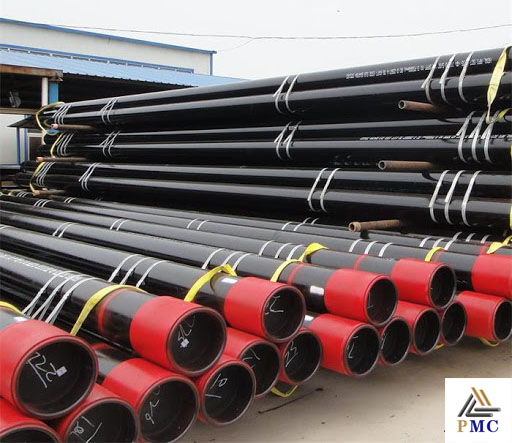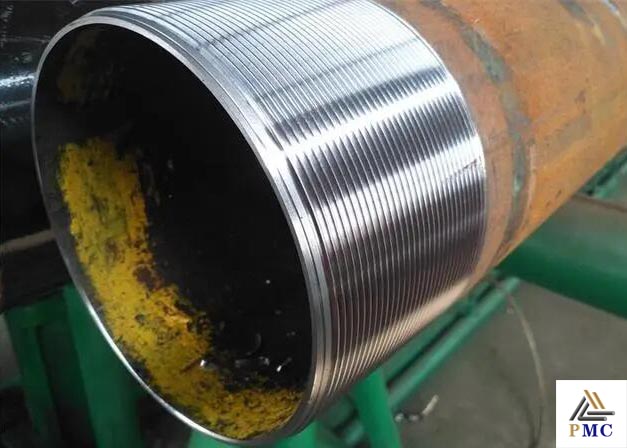
Quality Defects and Prevention of Oil Well Pipe
The quality defects of oil well pipes mainly come from three aspects:
The first is the quality defect of the oil well pipe body itself, such as the mechanical properties of the pipe body, the inner connection, the weighing, etc., which do not meet the requirements;
The second is the quality defect produced during the processing of the oil well pipe, such as the thread parameters (taper, thread pitch, tooth height, shape and concentricity and tightness of the threads at both ends of the coupling) exceed the standard, thread black buckle, broken thread, threaded wall deviation, screwing torque exceeds the standard, leakage, thread thread damage (scratch, bruising), the quality of drill pipe welds does not meet the requirements, etc.;
The third is that the performance of oil well pipes, including anti-collapse performance, corrosion resistance, perforation performance and anti-sticking performance, etc. failed to meet the requirements.

Quality defects and prevention of oil well pipe thread processing:
During the thread processing of oil well pipes, the threads may have quality defects such as black leather buckle, screw thread partial wall, broken thread, thread rubbing (bumping) scratches, and thread parameters exceeding the standard.
(1) Threaded black leather buckle
The threaded black leather buckle shows that the local processing amount of the thread buckle is too small to appear "unsmooth", which is related to the outer diameter and wall thickness accuracy, ellipticity and straightness of the pipe end of the steel pipe. The black leather buckle on the pipe body is often caused by the small outer diameter of the pipe body, the pipe end is not straight enough or the ellipse is too large. The black leather buckle of the coupling is generally caused by the outer diameter of the steel pipe being too positive or the pipe wall being too negative or the ovality is too large.
(2) threaded side wall
The partial wall of the threaded button is that after the steel pipe has been threaded, the wall thickness is uneven on one side and thicker on the other. The reason for the partial wall of the screw thread is similar to that of the black leather button of the thread, which is caused by the uneven wall thickness, bending or too large ellipticity of the pipe end of the steel pipe. Sometimes when there is partial wall in thread processing or the control of processing amount is unreasonable, there may also be excessive tolerance of thread bottom wall thickness, which will seriously affect the connection strength of oil well pipes.
(3) Thread breaking
When the thread comb cutter cuts the thread at high speed and powerfully, once the threaded thread collapses and "drops flesh", it will cause the thread to break. usually. The broken button is mainly caused by the large-sized non-metallic inclusions in the steel, and it is also related to the quality of the thread comb and the stability of the threading process.
(4) Thread damage
Thread damage of oil well pipes includes bruises and abrasions. It is generated during the production, transportation and storage of finished products. In order to prevent the exposed thread of the oil well pipe from being bruised, crushed and rusted, in addition to ensuring that the thread does not collide with hard objects (such as transport rollers, inclined grates, etc.) Screw the outer protective ring with internal thread on the screw thread of the body, and screw the inner protective ring with external thread on the thread of the coupling.

The API Spec 5CT standard stipulates:
① The thread processing factory should screw on the inner and outer thread protection rings. The design, material and mechanical strength of the thread protection ring are required to protect the threads and pipe ends to avoid damage during normal handling and transportation;
② During the transportation and normal storage of oil and casing, the design and material of the thread protection ring are required to keep the thread from dirt and water. The normal inventory cycle is about 1 year;
③The material selection of the thread protection ring should not contain material components that may cause thread corrosion or cause the thread protection ring to stick to the thread, and can be applied to the service temperature of -46℃~+66℃:
④ Bare steel thread protection rings shall not be used on L80 steel grade 9Cr and 13Cr pipe bodies.
(5) The thread parameters exceed the standard
Thread processing is the most important process in the production of oil well pipes, and it is also a key process that determines the quality of the threads of oil well pipes. At present, the thread processing of most oil well pipes adopts special CNC machine tools. When processing threads, the workpiece is automatically centered and clamped floatingly. The tool for thread processing uses carbide tool, and the rotation of the spindle is infinitely variable.
There are two thread processing methods: one is that the workpiece rotates, and the tool performs plane feed motion; the other is that the workpiece does not move, and the tool rotates and feeds. These two types of machine tools have their own characteristics. The former is flexible in use. It not only has high productivity when processing general tapered threads, but also can process direct-connected and special connections and good air-tight threads (special buckles); The productivity of the former for processing general tapered threads is higher than that of the former, but the processing of special buckles requires the configuration of pre-processing machine tools.
Various parameters of the thread (pitch diameter, tooth height, taper, pitch, tooth profile angle, close distance, etc.) will have an impact on the connection strength and sealing performance of the thread. The thread tightness is the comprehensive value of the fluctuation of each individual parameter of the thread. Even if the individual parameters of the thread are qualified, the tight distance may be unqualified.
The accuracy of various parameters of the thread is not only related to the quality of the tube blank. It is also related to the method of thread processing, the type of machine tool and the stability of the processing process, as well as the dimensional accuracy and wear resistance of the thread comb cutter. When other conditions are the same, the dimensional accuracy of the thread comb determines the accuracy of the thread size. It is generally required that the dimensional tolerance of the threaded comb is only 1/3 to 1/4 of the product tolerance, or even higher.
(6) The torque and J value exceed the standard
The torque of the oil and casing refers to the make-up torque generated when the coupling and the pipe body are screwed together. The control torque is to ensure the connection strength between the coupling and the pipe body and the contact pressure stress on the side of the thread is large enough, and cooperate with the corresponding thread sealant to realize the anti-leakage of oil and casing. For API standard threads, the J value represents the distance from the pipe end to the center of the coupling after the coupling and the pipe body are tightened, and is one of the important parameters to determine the quality of the threaded connection.
(7) Leak
In order to avoid oil and casing pipe leakage caused by insufficient contact pressure between the oil and casing pipe body and the coupling thread, the oil and casing with couplings are subjected to hydrostatic pressure test according to the standard. The leakage of the threaded thread connecting the pipe body and the coupling is related to the type and quality of the threaded thread, oil, casing screwing and thread sealant quality and other factors. As far as the buckle type is concerned, the sealing performance of the circular thread is better than that of the trapezoidal thread, and the special screw thread is better. The high-precision threaded shape and reasonable oil and casing screwing torque are beneficial to improve the sealing performance of the threaded thread. Thread sealant can lubricate, fill thread gaps (seal), and prevent corrosion during coupling screwing and oil and casing use.
Go here to learn more about " Four Performances of Oil Well Pipe “


